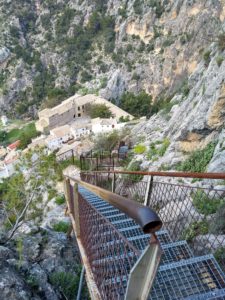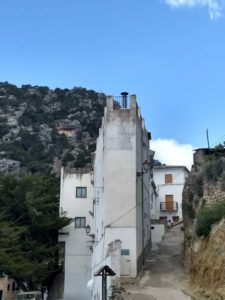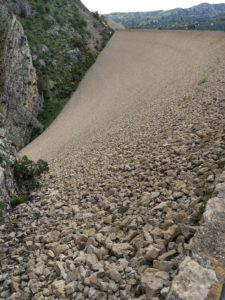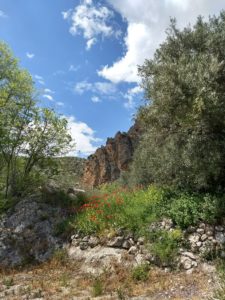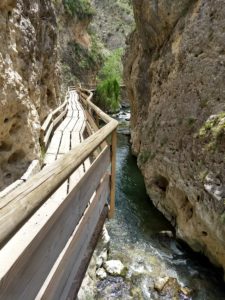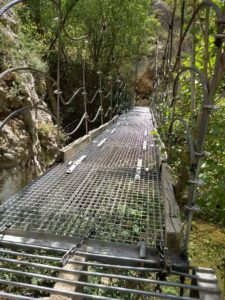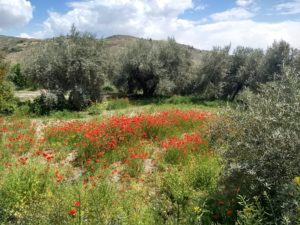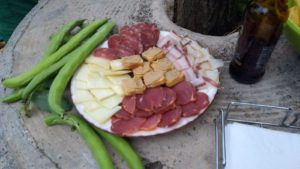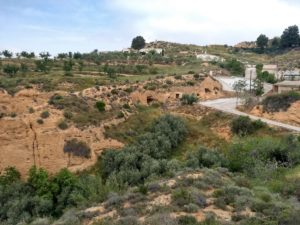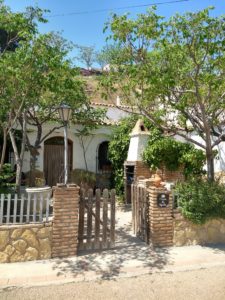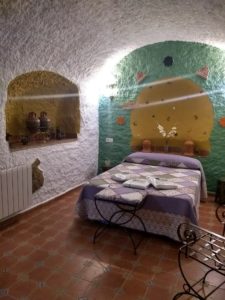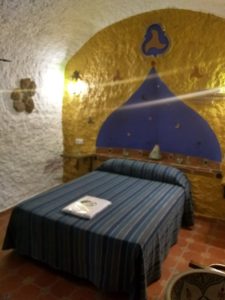Auf dem Weg nach Hinojares/Cazorla erklimmen wir die 220 Stufen zum Castillo de Tíscar, einer Burg aus dem 14. Jht. Die Weitsicht ist unglaublich, der Blick auf das an deren Fuss liegende Dorf zeigt Häuser, die ich nicht möblieren möchte…
On the way to Hinojares/Cazorla we climb the 220 steps to the Tíscar Castle, a fortress that dates back to the 14th century. The view is incredible, looking down we see some houses in the village at the feet of the castle that cling to the sides of the mountain and that I wouldn’t like to have to select te furniture for…
Der Parque Natural de Cazorla ist mit 210’000 ha der zweitgrösste Naturpark Europas. Wir machen eine Wanderung in die Umgebung des Stausees von Castril.
The Cazorla National Park is with 210,000 hectares Europe’s second largest, we go for a hike near the Castril dam.
Unsere Höhle – im wahrsten Sinn des Wortes – befindet sich am Rande des Naturparks in Hinojares, einer „Gemeinde“ Jaéns mit nur 310 Einwohner*innen. Drei davon lernen wir kennen, die Besitzer der Höhlenhotels und deren kleine Tochter (7), die mir ganz unerwartet am letzten Abend, während wir alle bei einem Apero vor unserem steinernen Heim plaudern, eine Fussmassage beschert. Zauberhaft, mit ihren kleinen Händen, und überdies sehr angenehm.
Our cave -literally- is just outside the national Park in Hinojares, the smallest independent county in Jaen with just 310 inhabitants. We get acquanted with three of them, the owners of the cave-hotel and their youngest daughter (7), that surprises me with a foot-massage during our farewell-party in front of our stony lodging. Her small fingers work magic and are very pleasant.
In einer Höhle übernachten? Wir machen das 4 Nächte lang, während früher Leute permanent dort wohnten. Einige bestehen noch, verfügen aber inzwischen über Wasser- und Stromanschluss. In Hinojares liegen einige Wohnhöhlen eingebettet in einen Barranco, eine trockene Schlucht.
Sleep in a cave? We do that four nights while people used to live permanently there and still do, in caves with all modern ammenities like water, electricity and communications. In Hinojares there are still some cave-neighborhoods that have residents, mainly around a Barranco, a dry gorge.
Die einzelnen Höhlen des Hotels sind gut ausgebaut, liebevoll hergerichtet, verfügen über Jacuzzi und privaten Vorplatz. Ein idealer Ort für Leute, die Aussicht, Natur, Entspannung und Ruhe geniessen wollen. Der neue Hammam ist im Bau, das kleine Freiluftschwimmbad längst in Betrieb. Und heizen tun die mit „Kernenergie“ – also, mit Olivenkernen.
Wir stranden in Hinojares zum Schluss unserer wunderbaren Andalusien-Rundreise. Irgendwann werden wir nach Málaga fliegen, ein Auto mieten und gut 2 Stunden später wieder Loli und José begrüssen, deren Eltern als Gastarbeiter in der Schweiz tätig waren.
The caves like the one we stay in are very nicely decorated, have their own little frontgarden and Jacuzzi. An ideal place for people looking for peace and tranquility in the middle of nature to relax and rest. A new Hammam is being built, the pool would be opnend next week. And the heating and warm water is generated by „stone-age“ technology.. olive stones are used as fuel in a furnace to generate heat.
Hinojares is the last Andalusian part of our trip. Someday we will fly to Malaga, get a car and drive the two hours to see Loli and José again, whose parents were immigrant workers in Switzerland.
Am 10. Mai nehmen wir Abschied von Andalusien und fahren Richtung Alfaz. Der anfänglich nur bewölkte Himmel verdunkelt sich zunehmend. Ich ignoriere die ersten Tropfen und erachte die Scheibenwischer als unnötig. Auf der Höhe von Almansa (Kastilien-La Mancha) kapituliere ich, die Wischer müssen arbeiten. Etwa 200m vor mir sehe ich einen dunklen Vorhang tief auf die Autobahn hängen. Die Strasse glänzt schwarz. Der Wind drückt uns in die Flanken. Svend ruhig: „Da vorne wird es wohl etwas heftig“. Wir denken beide an die Szene in „Bienvenue chez les Ch’tis“, in welcher der Hauptprotagonist beim Strassenschild von Nord-Pas-de-Calais in die Regenwand fährt. Ich tauche auch in die Regenwand ein, wir lachen, die Scheibenwischer fegen bei Tempo 60 km/h auf Stufe 3 übers Glas.
On May 10th we say goodbye to Andalusia and drive on towards Alfaz. The blue sky starts getting grey and dark, I ignore the first drops and deliberately do not switch on the wipers. Around Almansa (Castille-La Mancha) I capitulate and the wipers clear the sight of the motorway. Some 200 meters in front of us there is a dark curtain hanging over the motorway. The tarmac shines dark. The wind presses against the sides of the car. Svend says calmly „That looks a bit wild out in the front“. We both think of the scene in „Bienvenue chez les Ch’tis“, where the main character drives into a wall of rain as he reaches the sign I also dive into the rainwall, we laugh, while the wipers on high try to cope with the watermasses showering our car as we slow down to 60 kph.


